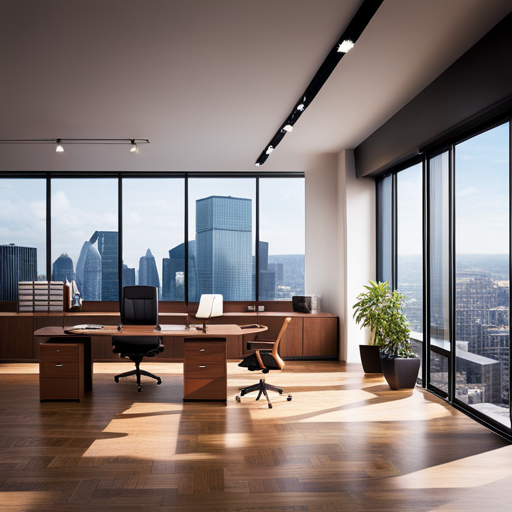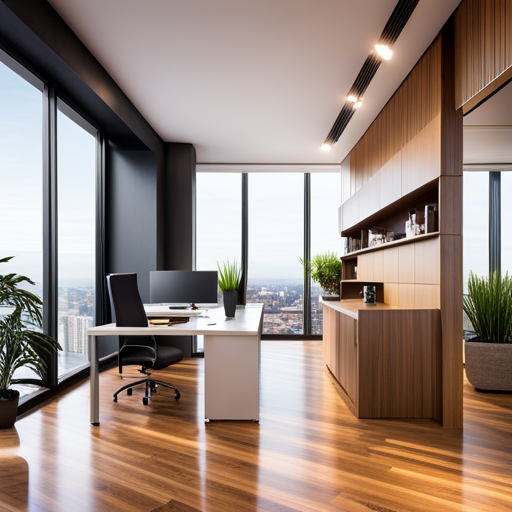The Impact of Flooring on Office Productivity

The choice of flooring in an office space may seem insignificant, but its impact on productivity can be monumental. From carpet to hardwood, each option can significantly affect the working environment. Understanding the factors that contribute to office productivity and the role of flooring is essential for creating a conducive workspace.
This article explores the profound influence of flooring choices on employee well-being, work efficiency, and overall productivity in the workplace.
Importance of Office Flooring
The importance of office flooring cannot be overstated in its influence on employee productivity and overall work environment. Aesthetically pleasing and well-maintained flooring can significantly impact employee satisfaction and create a positive work atmosphere. When employees are content with their workplace aesthetics, it can lead to higher levels of job satisfaction and overall productivity. On the contrary, neglected or unattractive flooring can have a detrimental effect on employee morale and well-being, ultimately affecting their performance.
Aesthetically pleasing flooring contributes to a positive first impression for both employees and visitors, setting the tone for a professional and well-maintained work environment. Furthermore, the choice of flooring material can also impact acoustics, comfort, and safety within the office space, all of which play a crucial role in maintaining a conducive work environment.
Factors Affecting Productivity
Several key factors can significantly impact office productivity, including the physical workspace environment and ergonomic design. Creating an optimal work environment involves considering various elements that can influence employee performance and well-being.
Two essential factors that play a crucial role in shaping the office environment are ergonomic furniture and natural lighting.
-
Ergonomic Furniture: Providing employees with ergonomic chairs and desks promotes comfort and reduces the risk of musculoskeletal issues. Properly designed furniture supports good posture, reduces physical strain, and enhances overall work efficiency.
-
Natural Lighting: Access to natural light has been linked to improved mood, energy levels, and overall well-being. Exposure to natural light during the workday can help regulate circadian rhythms, leading to better sleep patterns and increased alertness during working hours.
-
Air Quality: Good air quality is essential for employee health and cognitive function. Proper ventilation and air purification systems can help reduce pollutants, allergens, and airborne irritants, creating a healthier and more productive workspace.
-
Noise Control: Minimizing noise distractions through thoughtful office layout, sound-absorbing materials, and designated quiet areas can significantly improve concentration and productivity.
Benefits of Carpet Flooring
Carpet flooring offers substantial noise reduction benefits in office settings, creating a more peaceful and focused work environment.
Additionally, the comfort and warmth provided by carpet flooring can enhance employee satisfaction and well-being, ultimately contributing to increased productivity.
These benefits make carpet flooring a compelling choice for organizations seeking to optimize their office space for maximum productivity.
Noise Reduction Benefits
Implementing carpet flooring in office spaces significantly reduces noise levels, contributing to a more productive work environment. The noise reduction benefits of carpet flooring include:
- Sound absorption: Carpets absorb sound, reducing the level of noise in the office environment.
- Improved acoustics: Carpet flooring contributes to better acoustics by minimizing echoes and reverberations.
- Enhanced concentration: Reduced noise levels lead to improved focus and concentration among employees.
- Healthier environment: Carpet flooring acts as a soundproofing solution, creating a more serene and peaceful workplace, which can positively impact employee well-being and productivity.
Carpet flooring not only serves as a productivity enhancement but also plays a vital role in creating a conducive work environment by minimizing disturbances and distractions caused by noise.
Comfort and Warmth Advantages
The use of carpet flooring in office spaces offers distinct advantages in comfort and warmth, contributing to a more inviting and pleasant work environment. Carpet flooring creates a comfortable environment for employees, providing a soft and warm surface that is conducive to long periods of standing or walking. This can lead to increased satisfaction and productivity among employees.
Additionally, carpet flooring provides insulation, contributing to energy efficiency by retaining warmth and reducing the need for excessive heating in colder months. The thermal resistance of carpet helps maintain a comfortable temperature, reducing the reliance on heating systems and subsequently lowering energy costs.
Drawbacks of Carpet Flooring
While carpet flooring has its benefits, there are also drawbacks to consider.
Carpets can trap allergens, leading to poor indoor air quality and potential health issues for employees.
Additionally, carpets can be difficult to clean and maintain, resulting in a less hygienic work environment and increased cleaning costs.
Furthermore, over time, carpets are prone to wear and tear, which may require frequent replacement and contribute to higher long-term costs for the office.
Carpet Traps Allergens
Carpet flooring can trap allergens, potentially affecting the indoor air quality in office environments. This can have a significant impact on the health and productivity of employees. Some key points to consider regarding this issue include:
-
Allergen Control: Carpets can harbor dust mites, pet dander, and other allergens, making it challenging to maintain a clean and allergen-free environment.
-
Indoor Air Quality: The accumulation of allergens in carpets can lead to poor indoor air quality, triggering allergies and respiratory issues among employees.
-
Maintenance Challenges: Regular vacuuming and deep cleaning are necessary to minimize allergens, adding to the maintenance costs and time investment for carpeted spaces.
-
Potential Health Impacts: Prolonged exposure to allergens trapped in carpets may result in health issues, leading to increased absenteeism and reduced productivity.
Effectively managing allergens in carpeted office spaces is crucial for maintaining a healthy work environment.
Difficult to Clean
Maintaining cleanliness of carpeted office spaces poses a significant challenge due to the accumulation of debris and allergens.
The dense fibers of carpets tend to trap dirt, dust, and other particles, making it difficult to maintain a pristine appearance. This presents difficult maintenance and cleaning challenges, as regular vacuuming may not effectively remove embedded debris.
Additionally, spills and stains can become stubborn, requiring specialized cleaning methods and products. The presence of allergens, such as dust mites and pet dander, further exacerbates the cleaning difficulties, as conventional cleaning methods may not entirely eliminate these microscopic irritants.
As a result, the labor-intensive nature of keeping carpeted areas clean not only demands additional resources but also potentially impacts the overall hygiene and air quality of the office environment.
Wear and Tear
Amid the daily foot traffic and furniture movement in office spaces, carpet flooring is susceptible to accelerated wear and tear, necessitating frequent maintenance and potential replacement. This drawback of carpet flooring can significantly impact office productivity due to the following reasons:
-
Durability concerns: Carpets tend to show signs of wear and tear more quickly than other flooring options, leading to a shorter lifespan.
-
Increased maintenance costs: Regular cleaning, stain removal, and carpet replacement contribute to higher maintenance expenses over time.
-
Aesthetic deterioration: Heavy foot traffic and furniture can cause carpets to lose their original appearance, affecting the overall aesthetic of the office space.
-
Health and safety risks: Worn-out carpets may pose tripping hazards and collect more allergens, impacting the well-being of employees.
Advantages of Hardwood Flooring
When considering office flooring options, the advantages of hardwood flooring are numerous and significant. Hardwood flooring offers exceptional durability, requiring minimal maintenance compared to other flooring options. This characteristic reduces the need for frequent repairs and replacements, saving both time and money in the long run. Additionally, hardwood floors contribute to the aesthetic appeal of an office space, providing a timeless and sophisticated look that can enhance the overall atmosphere and leave a lasting impression on clients and employees. Furthermore, hardwood flooring aligns with sustainable practices as it is a natural, renewable resource, making it an environmentally friendly choice for office spaces. This sustainability aspect can positively influence the perception of a company, reflecting its commitment to eco-conscious decisions. The following table illustrates the key advantages of hardwood flooring in office settings:
| Advantages | Description | Emotional Response |
|---|---|---|
| Durability | Minimal maintenance | Confidence |
| Aesthetic | Timeless appeal | Professionalism |
| Sustainability | Eco-friendly choice | Responsibility |
Disadvantages of Hardwood Flooring
While acknowledging the durability and aesthetic appeal of hardwood flooring, it is important to consider the potential drawbacks associated with its use in office spaces.
-
Hardwood maintenance: Hardwood flooring requires regular maintenance to keep its luster and durability. This can include periodic refinishing, polishing, and protection from moisture, which can be time-consuming and costly for office management.
-
Slippery surface: Hardwood floors can become slippery, especially when wet or polished, posing a potential hazard for office employees. This may increase the risk of workplace accidents and injuries, impacting productivity and employee well-being.
-
Susceptibility to damage: Despite its durability, hardwood flooring is susceptible to scratches, dents, and other forms of damage from heavy office furniture, high heels, and regular foot traffic. Repairing and restoring these damages can disrupt office operations and incur additional expenses.
-
Noise transmission: Hardwood floors can amplify noise, leading to increased sound transmission between floors and throughout the office space. This can create distractions and reduce overall productivity in the workplace.
Considering these factors, while hardwood flooring offers many benefits, it’s important for office managers to weigh these potential disadvantages when choosing the most suitable flooring for their workplace.
Impact of Flooring on Employee Health
Using ergonomic flooring in the workplace can significantly contribute to employees’ health and well-being. The type of flooring in an office environment can have a direct impact on employee satisfaction and overall health. Flooring materials play a crucial role in maintaining good indoor air quality, preventing slips and falls, and reducing the strain on employees’ joints and muscles.
| Benefits of Ergonomic Flooring | Description |
|---|---|
| Improved Air Quality | Ergonomic flooring materials like cork or carpet tiles can trap dust and allergens, thereby improving indoor air quality and reducing respiratory issues. |
| Reduced Fatigue and Discomfort | Properly cushioned flooring reduces the physical strain on employees, minimizing fatigue and discomfort, which can contribute to better overall health. |
| Enhanced Safety | Non-slip and cushioned flooring options can significantly reduce the risk of slips, trips, and falls, promoting a safer working environment. |
| Sound Absorption | Certain ergonomic flooring materials can absorb sound, creating a quieter and less stressful work environment, which can positively impact employee health and well-being. |
Creating an Ideal Office Environment
The type of flooring in an office environment can contribute significantly to creating an ideal office environment, promoting employee health and productivity. When designing an ideal office environment, several factors should be considered, such as:
-
Comfortable and Ergonomic: Utilizing flooring materials that provide cushioning and support can contribute to creating a comfortable and ergonomic environment for employees, reducing the risk of discomfort and fatigue.
-
Acoustically Sound: Flooring materials that absorb sound and minimize noise can help create a peaceful and focused work environment, ultimately enhancing employee satisfaction and productivity.
-
Aesthetically Pleasing: Choosing visually appealing flooring options can contribute to a positive and uplifting atmosphere, promoting a sense of well-being and contentment among employees.
-
Easy to Maintain: Opting for low-maintenance flooring solutions can ensure a clean and organized workspace, reducing stress and contributing to an ideal working environment.
Frequently Asked Questions
What Are the Most Popular Flooring Options for Office Spaces?
The most popular flooring options for office spaces are those that offer durability and low maintenance, such as carpet tiles, vinyl, and laminate. These options also provide soundproofing benefits and aesthetic appeal, catering to various office design preferences.
How Does the Cost of Different Types of Flooring Compare?
When comparing the cost of different flooring types for office spaces, it’s essential to consider installation challenges. For example, while carpeting may have a lower upfront cost, it requires more maintenance and replacement, potentially impacting long-term expenses.
What Are Some Unique Design Trends in Office Flooring?
Innovative patterns and sustainable materials are shaping the latest office flooring design trends. From geometric shapes to nature-inspired textures, workplaces are embracing visually engaging and eco-conscious flooring options to create modern and vibrant environments.
Can Different Types of Flooring Affect Noise Levels in the Office?
Different types of flooring can significantly affect noise levels in the office. Proper selection can contribute to noise reduction and improved workplace acoustics, creating a more conducive environment for productivity and focus.
Are There Any Environmentally Friendly Flooring Options for Offices?
When considering environmentally friendly flooring options for offices, it’s essential to prioritize sustainable materials. Eco-friendly options such as bamboo, cork, reclaimed wood, and recycled materials can contribute to a more sustainable workspace.
Conclusion
In conclusion, the choice of office flooring has a significant impact on employee productivity and health.
Carpet flooring offers benefits such as noise reduction and comfort, but it can also harbor allergens and require frequent maintenance.
On the other hand, hardwood flooring provides a sleek and professional look, but it can be noisy and uncomfortable to stand on for long periods.
Creating an ideal office environment requires careful consideration of the flooring to optimize productivity and employee well-being.

Rubin Everest, a seasoned expert in the world of flooring, brings a wealth of knowledge and passion to the surface. As the mind behind ebbow.com, Rubin is dedicated to sharing insights on the latest trends, innovative solutions, and expert advice in the realm of flooring. Whether you’re seeking practical tips for installation or design inspiration, Rubin Everest is your go-to source for all things flooring-related, making your journey to the perfect floor an informed and enjoyable experience.





